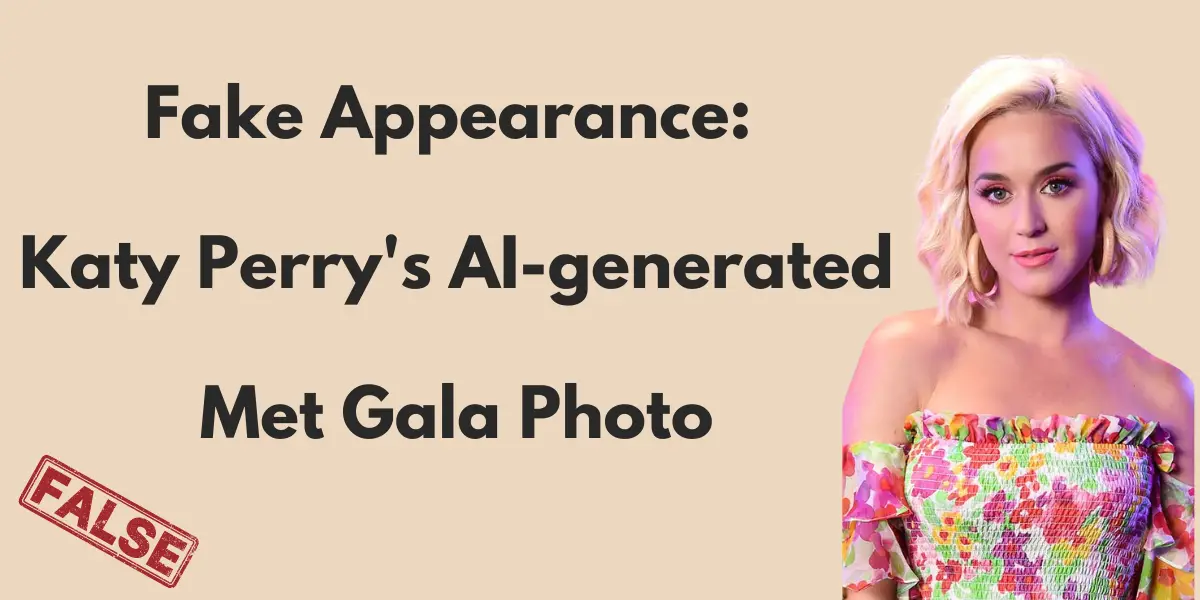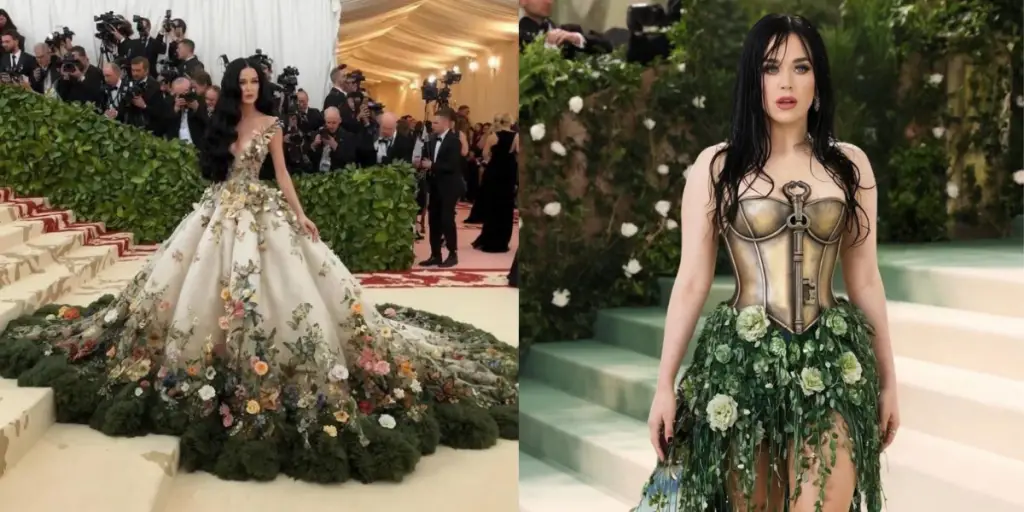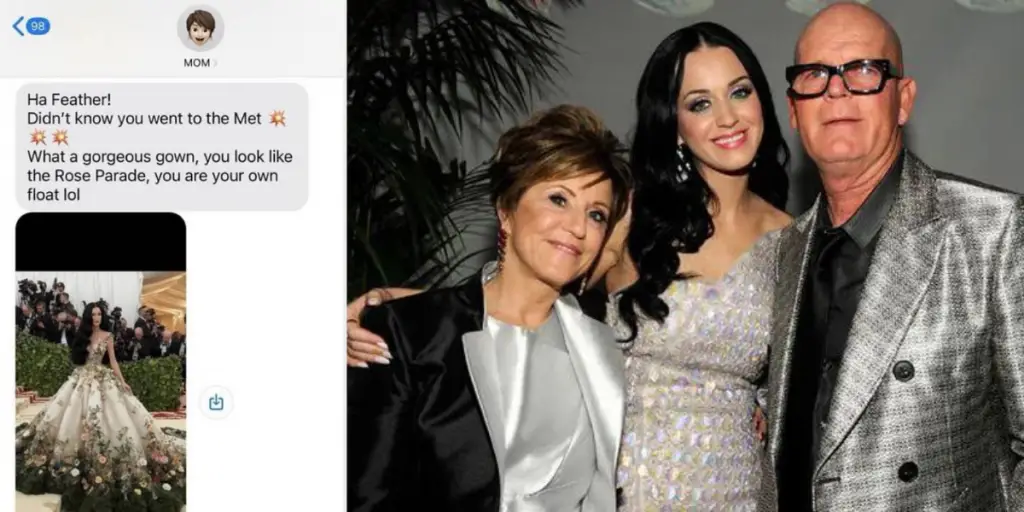Fake Appearance: Katy Perry's AI-generated Met Gala Photo

In an era where digital realities are increasingly blurring with actual events, the 2024 Met Gala witnessed an unprecedented spectacle: Katy Perry’s appearance, crafted not by designers but by artificial intelligence. This article explores the layers of this digital deception, from the creation of the images to the wide-ranging implications they hold.
This article explores Katy Perry’s AI-generated Met Gala photo that fooled many, including her own mother, discussing its creation, public reaction, and ethical concerns.
Table of Contents
What happened to Katy Perry?

Despite her notable past appearances at the Met Gala, Katy Perry did not attend the 2024 Met Gala, yet AI-generated images portrayed her as if she had graced the event. These images, created by fans using sophisticated AI tools, depicted Perry in elaborate, thematic costumes fitting the Gala’s “Garden of Time” theme. The fans behind the images used AI software to blend real photos and generated elements, creating a convincing visual that Perry was present at the Gala. These images spread quickly across social media and even fooled close family members, leading to widespread media coverage and public discourse on the implications of AI in media and public perception. The incident highlighted not just the capabilities of current AI technology but also raised questions about authenticity and trust in the digital age.
Katy Perry's response to the fake AI photos

Upon realizing the widespread circulation and the resultant confusion from the AI-generated images, Katy Perry took to social media to clarify the situation. She humorously addressed the images, revealing to her followers that they were artificial and not actual photographs from the Met Gala. Perry posted a screenshot of a text conversation with her mother, who had been deceived by the fake images, alongside a caption explaining her absence from the event due to work commitments. This response was not only a playful acknowledgment of the confusion caused by the AI images but also served as a subtle critique of the technology’s potential for misuse. Perry’s engagement with the issue helped spark a broader conversation about the ethical use of AI in creating deceptive media.
Also read: The Taylor Swift AI Outrage: Fans Rally Against Deepfake Dilemma
How did AI create Katy Perry's Met Gala look?
The AI-generated image of Katy Perry is the product of meticulous digital art. Using AI image generator like Bing’s Copilot Designer and the enhancements of Leonardo.AI, creators fine-tuned the visuals to achieve a high degree of realism. The images blended AI-generated elements with real photos, with texture adjustments and lighting added to create what the characters would look like at the party.
Also read:
Why was Katy Perry’s family fooled by Katy Perry's AI photos?

Katy Perry’s family, particularly her mother, was deceived by the AI-generated photos due to a combination of technical sophistication and contextual believability. These factors created a perfect storm that led to the initial acceptance of the images as real.
Technological Realism
The AI photos of Katy Perry were crafted with high precision, using advanced image generation tools that accurately mimicked her physical characteristics and fashion style. The technology has reached a point where the generated images can replicate subtle nuances that typically signify authenticity, such as accurate lighting, shadows, and even plausible interactions with photographed environments.
Emotional Connection
Family members are naturally predisposed to see authenticity in images of their loved ones. Katy Perry’s mother, seeing a photo that perfectly captured her daughter’s likeness, was influenced by her emotional connection, which overrode any initial skepticism. This emotional response to familiar faces is a common reason why family members can be easily misled by realistic AI-generated images.
Contextual Plausibility
The timing and setting of the photos also played a critical role. Released during the Met Gala—a high-profile event that Katy Perry has attended in the past—the images featured her in glamorous attire fitting the event’s theme. This contextual relevance made the photos seem more credible, as they aligned with what her family would expect from such an occasion.
Public reaction to Katy Perry's AI-Generated photos
The public reaction to Katy Perry’s AI-generated Met Gala photos was a mix of amusement and alarm. Social media platforms buzzed with discussions about the technological prowess behind the images, while also expressing concern over the ease with which digital content could manipulate reality.
- Skepticism and Amazement:Many were skeptical of the images, questioning their authenticity due to subtle discrepancies in details like the venue’s décor.
- Concerns Over Misinformation:The incident underscored worries about how AI can be used to create convincing misinformation, affecting public opinion and personal relationships.
- Fascination with AI Capabilities:Conversely, there was fascination with the advancing capabilities of AI, highlighting a growing trend in digital creativity and the potential for new forms of artistic expression.
Legal and ethical concerns raised by AI image
The creation and distribution of AI-generated images of Katy Perry not only entertained but also elicited serious legal and ethical concerns. As technology advances, the line between real and artificial becomes increasingly blurred, prompting a reevaluation of laws and ethical standards.
Legal Implications
Legally, the use of Katy Perry’s likeness raises questions about copyright and personality rights. Without her consent, the creation and distribution of her AI-generated images could potentially violate intellectual property laws designed to protect an individual’s image and likeness from unauthorized commercial use.
Ethical Challenges
Ethically, the situation touches on the integrity of information and the potential harm that such images could cause. The deceptive nature of AI-generated images can lead to misunderstandings and spread misinformation, potentially damaging reputations and misleading the public. The incident underscores the need for ethical standards in the creation and use of synthetic media.
Potential dangers of AI-generated image in Public
AI-generated images present several dangers in public contexts, where the distinction between real and fake can have significant consequences. The incident involving Katy Perry at the Met Gala illustrates some of these potential risks.
Misrepresentation and Deception
The primary danger lies in the potential for AI to misrepresent reality, deceiving the public and even influencing historical records. Fake images can create false narratives or alter people’s perceptions of events, celebrities, and political figures, leading to widespread misinformation.
Manipulation and Exploitation
There is also the risk of manipulation and exploitation, where AI-generated images are used to harm individuals or groups. Such technology can be weaponized to create compromising or harmful scenarios that never occurred, affecting public opinion and personal lives.
How can society prevent future AI image incidents?
As AI technology continues to evolve, society must adopt measures to mitigate the risks associated with AI-generated images. These measures should focus on enhancing the responsible development and use of AI while safeguarding public trust.
Implementing Robust Legal Frameworks
To address these challenges, robust legal frameworks need to be established that specifically govern the use of AI in creating images. These laws should protect individuals’ rights without stifling innovation, providing clear guidelines on consent, copyright, and the use of synthetic media.
Promoting Transparency and Literacy
Increasing transparency about the use of AI-generated content and improving digital literacy among the public are essential. People need to be educated about the nature of AI-generated images and how to distinguish them from real ones. Platforms and creators should disclose the use of AI in their content, helping consumers make informed decisions about the media they consume.
Advancing Technological Solutions
Finally, developing technological solutions that can detect and label AI-generated images is crucial. Tools that automatically analyze and flag synthetic content can help platforms and users identify fake images, reducing the risk of deception and misuse.
Conclusion
Katy Perry’s AI-generated Met Gala appearance serves as a stark reminder of the double-edged sword that AI technology represents. While it opens up new realms of creativity, it also poses significant challenges in ethics and misinformation. As AI continues to evolve, so too must our strategies for understanding, regulating, and integrating this powerful technology into society.

